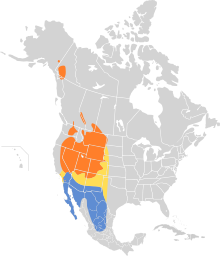Brewer's sparrow
| Brewer's sparrow | |
|---|---|

| |
| Adult S. b. breweri in Deschutes National Forest, Oregon | |
| Scientific classification | |
| Domain: | Eukaryota |
| Kingdom: | Animalia |
| Phylum: | Chordata |
| Class: | Aves |
| Order: | Passeriformes |
| Family: | Passerellidae |
| Genus: | Spizella |
| Species: | S. breweri
|
| Binomial name | |
| Spizella breweri Cassin, 1856
| |

| |
Brewer's sparrow (Spizella breweri) is a small, slim
Description and systematics
Adults have grey-brown backs and speckled brown crowns, both with dark streaks, and a pale eye-ring. Their wings are brown with light wing bars and the underparts are pale grey. Their bill is pale with a dark tip and they have a long notched tail. They are similar in appearance to the clay-colored sparrow (S. pallida) but do not have a pale stripe on the crown or grey neck patch.
Measurements:[3]
- Length: 5.1-5.9 in (13-15 cm)
- Weight: 0.4-0.5 oz (11-14 g)
- Wingspan: 7.1-7.9 in (18-20 cm)
The male sings to defend a nesting territory. The song is a long varied mix of notes and trills. Males have two distinct types of songs – classified as short and long songs.
There are two distinct subspecies:
- Brewer's sparrow proper, Spizella breweri breweri
- Found in brushy areas, especially with sagebrush, in southern parts of western Canada and in the western United States.
- Timberline sparrow, Spizella breweri taverneri
- Found in thicketed areas around the tree line in the Rockies of British Columbia, Alberta, and northern Montana, the southern Yukon, and southeastern Alaska. These birds are somewhat darker and larger than the southern subspecies; some consider this to be a separate species.
Ecology and status
These birds
Brewer's sparrow has decreased in some parts of its range. Causes are not well understood, but it is suspected that the decline is due at least in part to destruction of sagebrush habitat. Additional information on resource use and limitation during the wintering season is desperately needed. When the timberline sparrow was still considered a good species, Brewer's sparrow was classified as
References
- . Retrieved 2 November 2022.
- ^ Brewer's Sparrows (Spizella breweri). Beautyofbirds.com (previously avianweb.com). Retrieved on 2014-05-05.
- ^ "Brewer's Sparrow Identification, All About Birds, Cornell Lab of Ornithology". www.allaboutbirds.org. Retrieved 2020-09-29.
- ^ BirdLife International (2008) Brewer's Sparrow Species Factsheet, 2008 IUCN Redlist status changes Archived September 14, 2008, at the Wayback Machine.
External links
- "Effects of Management Practices on Brewer's Sparrow" – NPWRC
- Brewer's sparrow – Spizella breweri – USGS Patuxent Bird Identification InfoCenter
- Brewer's sparrow photo gallery VIREO

